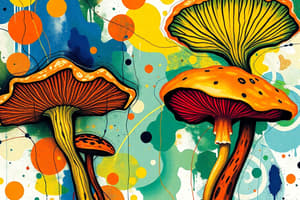Podcast
Questions and Answers
What is the primary means by which fungi reproduce?
What is the primary means by which fungi reproduce?
- Spore production (correct)
- Budding
- Vegetative propagation
- Binary fission
What is the structural component that provides support and protection in fungi?
What is the structural component that provides support and protection in fungi?
- Chitin (correct)
- Cellulose
- Collagen
- Keratin
Which of the following is a characteristic of fungal enzymes?
Which of the following is a characteristic of fungal enzymes?
- They are limited to animal tissues.
- They function only in aerobic conditions.
- They can break down a variety of complex molecules. (correct)
- They only digest carbohydrates.
What role do exoenzymes play in fungal nutrition?
What role do exoenzymes play in fungal nutrition?
What type of nutritional strategy do fungi employ?
What type of nutritional strategy do fungi employ?
Hyphal growth in fungi results in the formation of which structure?
Hyphal growth in fungi results in the formation of which structure?
Which type of reproduction involves meiosis in fungi?
Which type of reproduction involves meiosis in fungi?
What is the primary advantage of fungal enzyme versatility?
What is the primary advantage of fungal enzyme versatility?
What is the primary structure through which fungi absorb nutrients?
What is the primary structure through which fungi absorb nutrients?
What type of nutrition do fungi primarily exhibit?
What type of nutrition do fungi primarily exhibit?
Which of the following characteristics is found in the cell walls of most fungi?
Which of the following characteristics is found in the cell walls of most fungi?
How does the structure of hyphae contribute to fungal nutrition?
How does the structure of hyphae contribute to fungal nutrition?
Which process do fungi use to break down complex organic materials?
Which process do fungi use to break down complex organic materials?
What are the thread-like structures that make up the body of fungi called?
What are the thread-like structures that make up the body of fungi called?
Which factor primarily helps fungi to perform decompositional roles in their ecosystems?
Which factor primarily helps fungi to perform decompositional roles in their ecosystems?
What is the estimated range of fungal species described so far?
What is the estimated range of fungal species described so far?
What distinguishes microsporidians from other fungi in terms of spore structure?
What distinguishes microsporidians from other fungi in terms of spore structure?
Which characteristic is common to both chytrids and other fungi?
Which characteristic is common to both chytrids and other fungi?
What type of spores do chytrids produce for asexual reproduction?
What type of spores do chytrids produce for asexual reproduction?
In what environments are chytrids predominantly found?
In what environments are chytrids predominantly found?
What role does the polar tube play in microsporidian parasites?
What role does the polar tube play in microsporidian parasites?
How do microsporidians primarily affect honeybee populations?
How do microsporidians primarily affect honeybee populations?
What is the significance of chitin in the cell walls of chytrids?
What is the significance of chitin in the cell walls of chytrids?
What common feature do microsporidians and chytrids share?
What common feature do microsporidians and chytrids share?
Study Notes
Fungal Biology and Characteristics
- Fungi are chemoheterotrophs that obtain nutrients by absorbing dissolved organic compounds from their environment.
- They secrete enzymes to break down complex molecules into simpler organic compounds.
- This absorptive nutrition allows fungi to utilize diverse food sources, including plant tissues, animal tissues, and other fungi.
- Fungi have a chitinous cell wall, which provides structural support and protection.
- Fungi reproduce by producing spores that can be generated through asexual (mitosis) or sexual (meiosis) reproduction.
Kingdom Fungi: Diversity and Importance
- Approximately 145,000 fungal species have been described, with estimates of up to 3.8 million remaining undiscovered.
- Fungi play vital roles in nutrient cycling and decomposition processes, making them essential for ecosystem function.
- Most species are found in soil, where they decompose organic material.
- Fungi are more closely related to Animalia than to Plantae, both belonging to the Opisthokonts (Unikonta) supergroup.
The Phylum Chytridiomycota (Chytrids)
- Chytrids are a low-diversity group (around 1,000 species) predominantly found in aquatic or moist environments.
- They include species found in soil, estuaries, and even within animal digestive tracts.
- Most chytrids are unicellular, although some form colonies with hyphae.
- Nearly all chytrids possess flagellated asexual spores called zoospores.
- Chytrids, like other fungi, have chitin cell walls and utilize external digestion.
Phylum Microsporidia
- Microsporidians are spore-forming, unicellular parasites that primarily infect animal hosts, especially insects.
- Nosema ceranae, a microsporidian parasite of honeybees, is suspected to contribute to Colony Collapse Disorder.
- Microsporidians lack flagellated spores and instead produce unique spores with an infection organelle called the polar tube.
- They can form resistant spores with chitin-rich cell walls, capable of surviving outside their host for extended periods.
Studying That Suits You
Use AI to generate personalized quizzes and flashcards to suit your learning preferences.
Related Documents
Description
Explore the fascinating world of fungi in this quiz, which covers their unique characteristics, nutritional methods, and importance in ecosystems. Delve into topics such as their chemosynthesis, structure, and reproductive strategies to gain a comprehensive understanding of this diverse kingdom.




